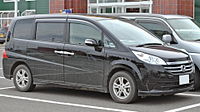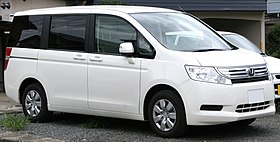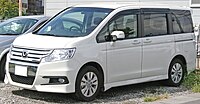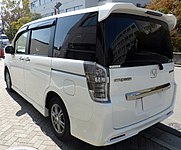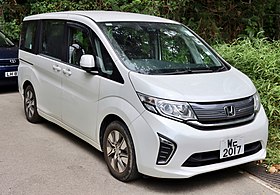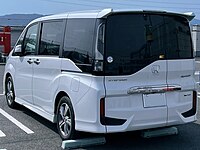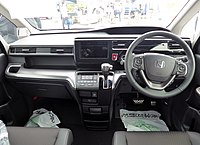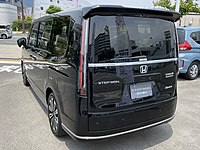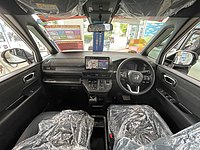
The Honda Integra, sold in North America as the Acura Integra and later the Acura RSX, is an automobile produced by the Japanese company Honda from 1985 until 2006, and then since 2021. It succeeded the Quint as a more luxurious and sport-oriented derivative of the Civic. The Integra was one of the launch models for Acura in the US in 1986 alongside the Acura Legend. Throughout its production run, the Integra was highly regarded for its handling and performance. The 1995–2001 Integra Type R is widely regarded as one of the best front-wheel-drive cars of all time.

The Honda Accord, also known as the Honda Inspire in Japan and China for certain generations, is a series of automobiles manufactured by Honda since 1976, best known for its four-door sedan variant, which has been one of the best-selling cars in the United States since 1989. The Accord nameplate has been applied to a variety of vehicles worldwide, including coupes, station wagons, hatchbacks and a Honda Crosstour crossover.

The Honda Fit or Honda Jazz is a small car manufactured and marketed by Honda since 2001 over four generations. It has a five-door hatchback body style and is considered a supermini in the United Kingdom, a subcompact car in the United States, and a light car in Australia. Marketed worldwide and manufactured at ten plants in eight countries, sales reached almost 5 million by mid-2013. Honda uses the "Jazz" nameplate in Europe, Oceania, the Middle East, Africa, Hong Kong, Macau, Southeast Asia and India; and "Fit" in Japan, Sri Lanka, China, Taiwan and the Americas.

The fourth-generation Honda Integra, produced by Honda, was introduced in Japan on 13 April 2001 and produced from July 2001 until August 2006. It was introduced in North America on 2 July 2001 as the Acura RSX, the name a part of Acura's naming scheme changing the names of its models from recognizable names like "Integra" or "Legend" to alphabetical designations in order for buyers to build more recognition to the marque, and not the individual cars.

The Honda City is a subcompact car which has been produced by the Japanese manufacturer Honda since 1981.

The Honda Stream is a car manufactured by the Japanese automaker Honda from 2000 to 2014. The second generation model was officially presented on 13 July 2006. It has been described as a multi-purpose vehicle (MPV) or as an estate car.

The Honda FR-V, marketed as the Honda Edix in Japan, is a six-passenger car that was manufactured by Honda from 2004 to 2009, over a single generation. A five-door compact multi-purpose vehicle (MPV), the FR-V was noted for its 3+3 seating configuration, along with the Fiat Multipla.

The Honda HR-V is a subcompact crossover SUV (B-segment) manufactured and marketed by Honda over three generations.

The Toyota Alphard is a minivan produced by the Japanese automaker Toyota since 2002. It is available as a seven or eight-seater with petrol and hybrid engine options. Hybrid variants have been available since 2003, which incorporates Toyota's Hybrid Synergy Drive technology. It is Toyota's flagship minivan.
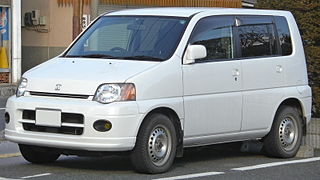
The Honda S-MX is a compact MPV produced by Honda, sold between 1996 and 2002.
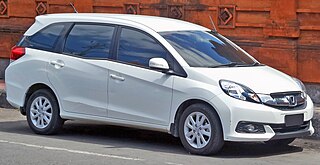
The Honda Mobilio is a seven-seat mini MPV produced by the Japanese automaker Honda. The first-generation Mobilio that was produced from 2001 to 2008 and sold exclusively in Japan. It was the second model in Honda's "Small Max" series and also took Honda's Global Small Platform and their i-DSI engine. In May 2008, the Freed was introduced, replacing the first-generation model. The second-generation Mobilio, which is based on the Brio, was introduced in September 2013 and went on sale in January 2014 for several emerging markets.

The Honda Freed is a mini MPV produced by the Japanese automaker Honda since 2008. The vehicle is designed mainly for the need of Japanese consumers. It is based on the Fit/Jazz platform and acts as a replacement for the first generation Mobilio in Japan. Three different versions of the Freed are available: a six-seater version which features captain’s seats in the second row, a seven-seater version and a five-seater version. Honda also stated that a wheelchair-accessible model is offered in addition to versions with a side lift-up seat and passenger lift-up seat.

The Honda Elysion is a seven- or eight-seat minivan initially sold only in Japan as a competitor to the Toyota Alphard and the Nissan Elgrand. The Honda LaGreat, marketed in the US as the Honda Odyssey, featured popular styling but was impractical in Japan due to its relatively large size. Subsequently, the Elysion was designed with styling cues from the LaGreat, but was made smaller to be competitive in the Japanese market.

The sixth-generation Honda Civic is an automobile produced by Honda from 1995 until 2000. It was introduced in 1995 with 3-door hatchback, 4-door sedan and 2-door coupe body styles, replicating its predecessor's lineup. The sixth-generation Civic offered two new 1.6-liter 4-cylinder engines and a new continuously variable transmission (CVT) on the HX model. The coupe and sedan are 2.3 in (58 mm) longer and the hatchback is 4.3 in (109 mm) longer than the previous-generation Civic. This was the last generation of Civic to have front double-wishbone suspension, as the succeeding seventh generation would change the front suspension to a MacPherson strut.

The seventh-generation Honda Civic is an automobile produced by Honda from 2000 until 2005. It debuted in September 2000 as a 2001 model. Its exterior dimensions stayed similar to the outgoing predecessor, with interior space significantly increased, bumping it up to the compact car size designation. A notable feature was the flat rear floor that gave better comfort to the rear seat passengers. This generation abandoned the front double wishbone suspension, used previously from fourth to sixth generations, replacing it with MacPherson struts. This generation was the last to offer 4WD variants.

The eighth-generation Honda Civic is a range of compact cars (C-segment) manufactured by Honda between 2005 and 2012, replacing the seventh-generation Civic. Four body styles were introduced throughout its production run, which are sedan, coupe, and both three-door and five-door hatchback. The sedan version was introduced with two distinct styling for different markets, with one of them sold as the Acura CSX in Canada and as the Ciimo 1.8 in China from 2012 until 2016. The hatchback versions formed the European-market Civic range, which received a different architecture, body design and smaller footprint, and solely produced in Swindon, United Kingdom.

The North American eighth generation Honda Accord is a mid-size car introduced in August 2007 for the 2008 model year. It is also marketed in parts of Asia and Australasia, and as the Honda Inspire in Japan.

The third generation Honda CR-V was launched for the 2007 model year. It went on sale in the U.S. during late September 2006. Unlike preceding models, it features a rear liftgate rather than a side-opening rear door and no longer has the spare tire mounted on the rear door. The new CR-V is lower, wider and shorter than the previous models; the length decrease is attributed mostly to the fact that the spare wheel no longer adds length to the back of the vehicle. A lowering of the centre of gravity is another benefit of the spare wheel being located underneath the rear cargo area. The centre rear seat pass-through was also introduced as a new feature on the third generation.

The tenth-generation Honda Civic(FC/FK) is a compact car (C-segment) manufactured by Honda from 2015 until 2022, replacing the ninth-generation Civic. It was first released in November 2015 in the North American market, followed by its introduction in Europe and Asia-Pacific in 2016, and in Japan in 2017. This generation marked the unification of the Civic range, as Honda ceased making a dedicated version for the European market—a strategy employed since the seventh-generation Civic—in favour of a globally marketed model. As the result, three body styles were introduced with a near-identical design which are sedan, hatchback, and coupe.

The second generation Honda Fit is a subcompact car or supermini manufactured by Honda from 2007 until 2014. It debuted on 17 October 2007 at the 40th Tokyo Motor Show.












